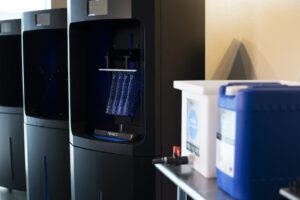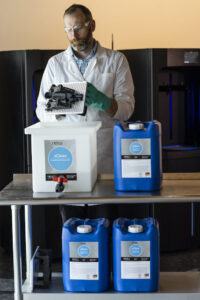- Xometry Joins QLS 820 Manufacturing Partner Network - March 22, 2023
- Weerg Offers Quick-Turn Resin 3D Printing Service by Installing Four NXE 400Pro Printers - March 22, 2023
- Nexa3D Acquires XYZ Printing’s SLS Technology - March 19, 2023
By Brent Zollinger
When Covid hit, our entire industry pivoted overnight, stepping up to support a broken traditional PPE supply chain to ensure the safety of healthcare workers and first responders. At Nexa3D, I was asked to stand up an entire flexible factory in less than a week to supply local hospitals with much needed face shields and other essential parts. Just as we began spooling up production, however, we encountered another kind of supply chain shortage. Isopropyl alcohol (IPA) became extremely scarce and its price skyrocketed. Like many in our industry, we were forced to explore alternatives so while working in shifts to keep up with demand, we also feverishly evaluated dozens of alternatives to IPA. We weren’t all that optimistic. After all, many of us had been in this space for decades and thought that we already knew of all the possible alternative options. With necessity being the mother of invention and the reality that our supply of IPA was rapidly depleting, we searched for at least a temporary solution.

Our persistence paid off. We zeroed in on what we now call xCLEAN and quickly embraced it in April as our go-to cleaning solvent. Fast forward a few months and thousands of serial production parts later in our flexible factory, we found with some small adjustments it was better in every way to IPA. We liked it so much that we decided to share this incredible cleaner with the entire photopolymer 3D printing community so everyone could give it a try.
But it gets even better. Becoming a heavy user out of necessity, we discovered that xCLEAN lasted much longer than other solvents. As we began to measure and record what was happening in our own facility, we realized that this cleaning solvent had three times the saturation limit of IPA, meaning that we were generating much less waste and had fewer solvent changeovers. Another big bonus was that xCLEAN was safer to handle than other cleaning solvents. It did not require any special storage or adherence to shipping regulations typically associated with post processing photopolymeric parts. Given our high volumes of production, avoiding special handling and storage was a big deal.

What makes xCLEAN so good? This solvent is composed of a relatively small molecule, allowing it to provide similar cleaning efficacy as IPA. Having both polar and non-polar ends, it won’t leave the greasy residue typical of TPM or DPM, and rinses off easily in water. xCLEAN’s primary component is common in a number of product you use every day including liquid soaps, cosmetics, and whiteboard cleaners. Add to the fact that xCLEAN can be recycled and recovered with a vacuum-assist solvent distillation unit, and the overall sustainability profile of xCLEAN is very attractive. Finally, it is compatible with most automated washing units on the market today, including closed loop systems, so any user can give it a try with confidence. We haven’t yet tested and cleared xCLEAN for cleaning parts printed from biocompatible resins, so as always, we recommend that users closely follow their material supplier’s wash recommendations to preserve the material’s biocompatibility.
I am very proud to be part of a team that is stepping up during this unprecedented pandemic, and quickly pivoting internal developments and external collaborations to adeptly support our growing customer base and the communities we live in. I am also grateful to be part of a company that throughout this challenging period continues to expand the range of our durable photoplastics and workflow productivity tools.
If you are still reading, give xCLEAN a try. It is compatible with most photopolymeric resin systems and automated cleaners.
